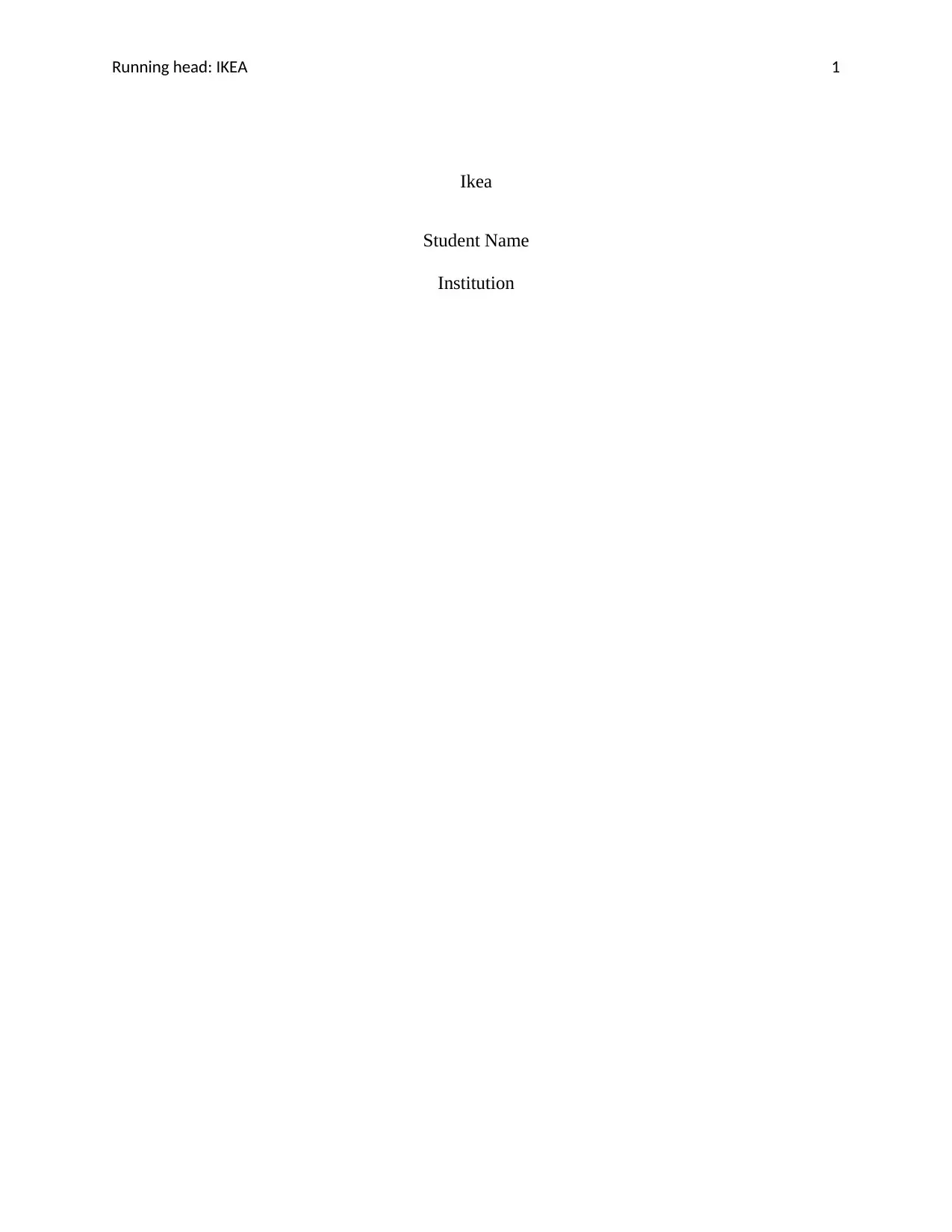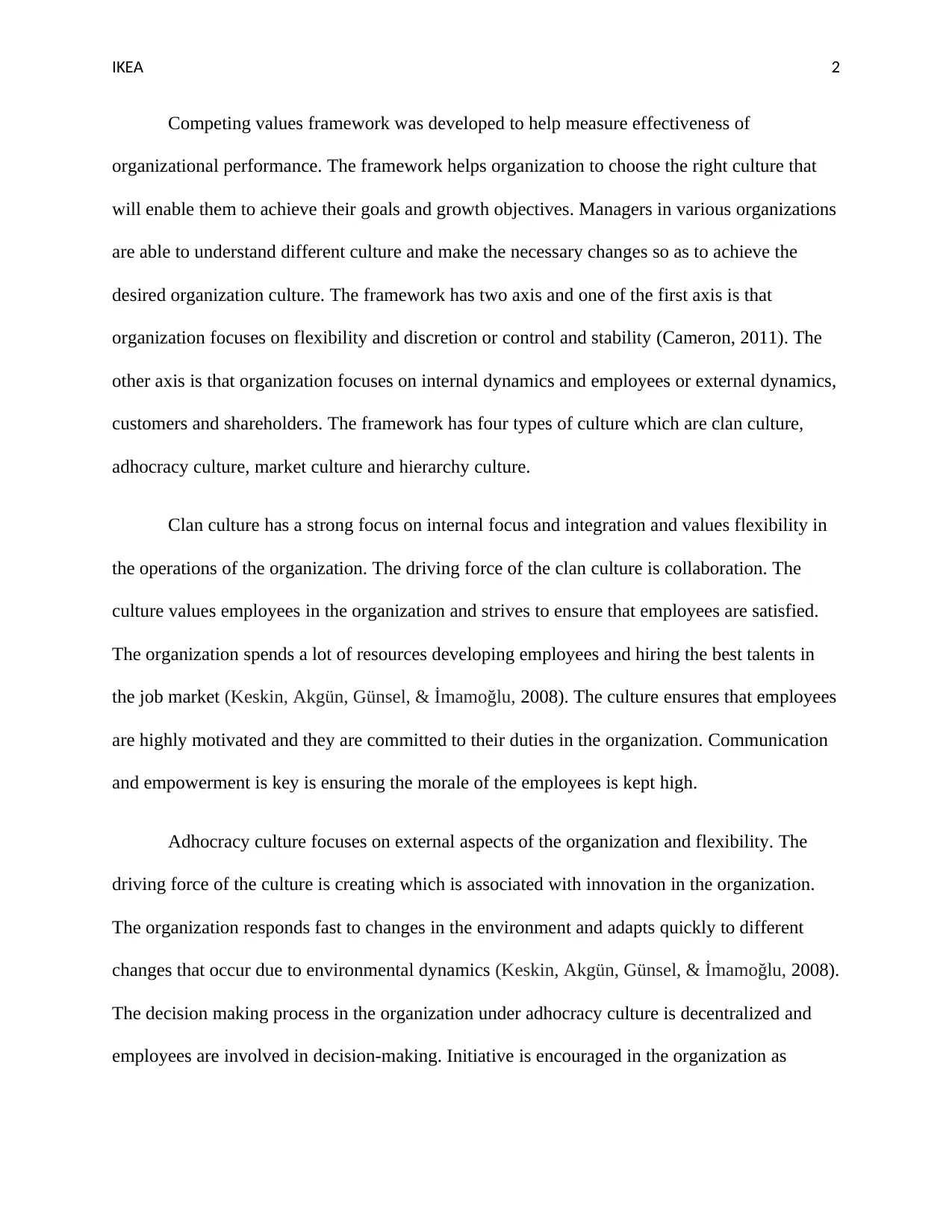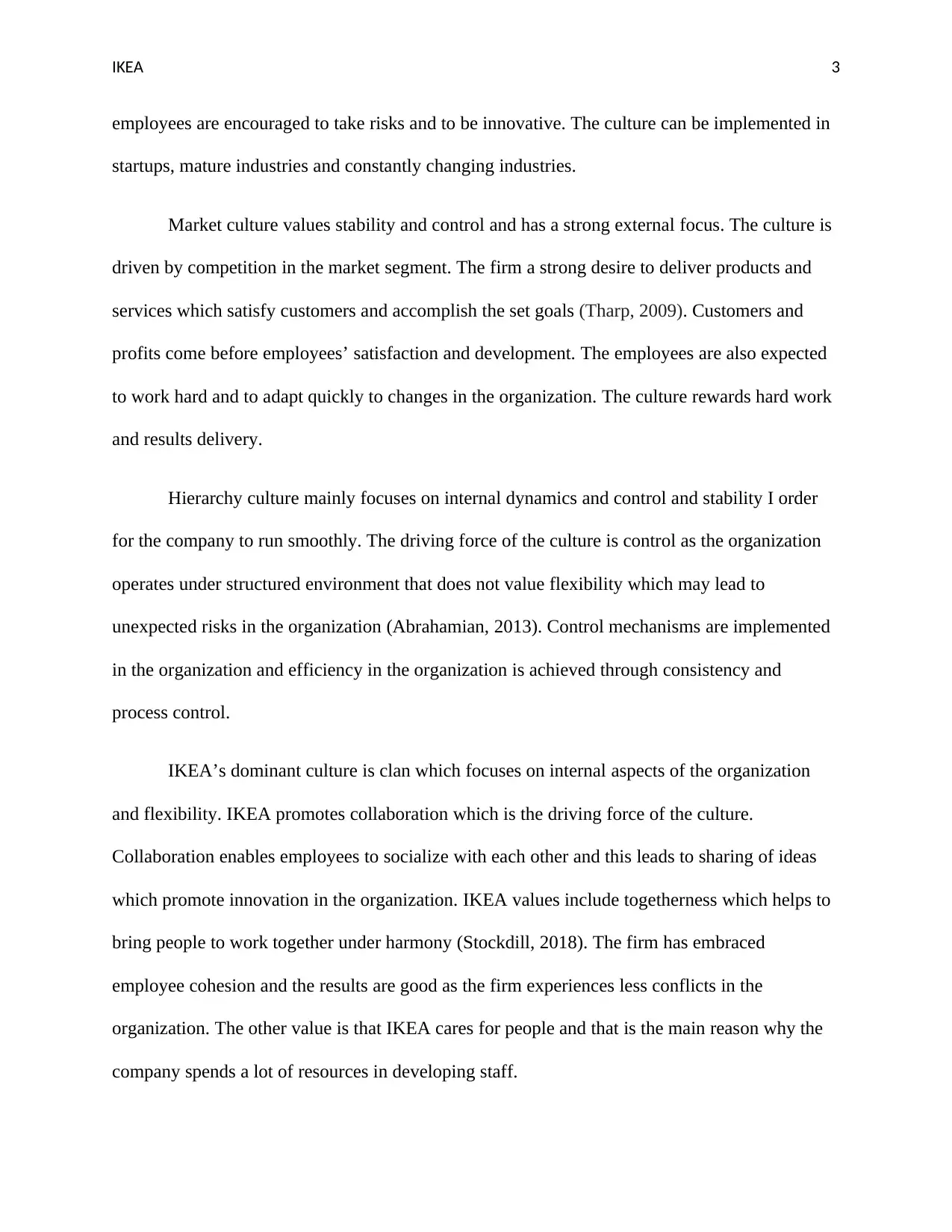IKEA's Organizational Culture: A Competing Values Framework Analysis
VerifiedAdded on 2023/06/03
|6
|1060
|463
Report
AI Summary
This report analyzes IKEA's organizational culture using the Competing Values Framework (CVF). It begins by explaining the CVF and its four cultural types: clan, adhocracy, market, and hierarchy. The report then identifies IKEA's dominant culture as clan, emphasizing internal focus, collaboration, and employee development. Evidence from IKEA's Southeast Asia website, including employee testimonials and company values, supports this determination. The report highlights IKEA's emphasis on togetherness, employee cohesion, and career progression, aligning with the characteristics of a clan culture. The report concludes by emphasizing the importance of selecting the appropriate culture to achieve organizational goals and growth objectives.

Running head: IKEA 1
Ikea
Student Name
Institution
Ikea
Student Name
Institution
Paraphrase This Document
Need a fresh take? Get an instant paraphrase of this document with our AI Paraphraser

IKEA 2
Competing values framework was developed to help measure effectiveness of
organizational performance. The framework helps organization to choose the right culture that
will enable them to achieve their goals and growth objectives. Managers in various organizations
are able to understand different culture and make the necessary changes so as to achieve the
desired organization culture. The framework has two axis and one of the first axis is that
organization focuses on flexibility and discretion or control and stability (Cameron, 2011). The
other axis is that organization focuses on internal dynamics and employees or external dynamics,
customers and shareholders. The framework has four types of culture which are clan culture,
adhocracy culture, market culture and hierarchy culture.
Clan culture has a strong focus on internal focus and integration and values flexibility in
the operations of the organization. The driving force of the clan culture is collaboration. The
culture values employees in the organization and strives to ensure that employees are satisfied.
The organization spends a lot of resources developing employees and hiring the best talents in
the job market (Keskin, Akgün, Günsel, & İmamoğlu, 2008). The culture ensures that employees
are highly motivated and they are committed to their duties in the organization. Communication
and empowerment is key is ensuring the morale of the employees is kept high.
Adhocracy culture focuses on external aspects of the organization and flexibility. The
driving force of the culture is creating which is associated with innovation in the organization.
The organization responds fast to changes in the environment and adapts quickly to different
changes that occur due to environmental dynamics (Keskin, Akgün, Günsel, & İmamoğlu, 2008).
The decision making process in the organization under adhocracy culture is decentralized and
employees are involved in decision-making. Initiative is encouraged in the organization as
Competing values framework was developed to help measure effectiveness of
organizational performance. The framework helps organization to choose the right culture that
will enable them to achieve their goals and growth objectives. Managers in various organizations
are able to understand different culture and make the necessary changes so as to achieve the
desired organization culture. The framework has two axis and one of the first axis is that
organization focuses on flexibility and discretion or control and stability (Cameron, 2011). The
other axis is that organization focuses on internal dynamics and employees or external dynamics,
customers and shareholders. The framework has four types of culture which are clan culture,
adhocracy culture, market culture and hierarchy culture.
Clan culture has a strong focus on internal focus and integration and values flexibility in
the operations of the organization. The driving force of the clan culture is collaboration. The
culture values employees in the organization and strives to ensure that employees are satisfied.
The organization spends a lot of resources developing employees and hiring the best talents in
the job market (Keskin, Akgün, Günsel, & İmamoğlu, 2008). The culture ensures that employees
are highly motivated and they are committed to their duties in the organization. Communication
and empowerment is key is ensuring the morale of the employees is kept high.
Adhocracy culture focuses on external aspects of the organization and flexibility. The
driving force of the culture is creating which is associated with innovation in the organization.
The organization responds fast to changes in the environment and adapts quickly to different
changes that occur due to environmental dynamics (Keskin, Akgün, Günsel, & İmamoğlu, 2008).
The decision making process in the organization under adhocracy culture is decentralized and
employees are involved in decision-making. Initiative is encouraged in the organization as

IKEA 3
employees are encouraged to take risks and to be innovative. The culture can be implemented in
startups, mature industries and constantly changing industries.
Market culture values stability and control and has a strong external focus. The culture is
driven by competition in the market segment. The firm a strong desire to deliver products and
services which satisfy customers and accomplish the set goals (Tharp, 2009). Customers and
profits come before employees’ satisfaction and development. The employees are also expected
to work hard and to adapt quickly to changes in the organization. The culture rewards hard work
and results delivery.
Hierarchy culture mainly focuses on internal dynamics and control and stability I order
for the company to run smoothly. The driving force of the culture is control as the organization
operates under structured environment that does not value flexibility which may lead to
unexpected risks in the organization (Abrahamian, 2013). Control mechanisms are implemented
in the organization and efficiency in the organization is achieved through consistency and
process control.
IKEA’s dominant culture is clan which focuses on internal aspects of the organization
and flexibility. IKEA promotes collaboration which is the driving force of the culture.
Collaboration enables employees to socialize with each other and this leads to sharing of ideas
which promote innovation in the organization. IKEA values include togetherness which helps to
bring people to work together under harmony (Stockdill, 2018). The firm has embraced
employee cohesion and the results are good as the firm experiences less conflicts in the
organization. The other value is that IKEA cares for people and that is the main reason why the
company spends a lot of resources in developing staff.
employees are encouraged to take risks and to be innovative. The culture can be implemented in
startups, mature industries and constantly changing industries.
Market culture values stability and control and has a strong external focus. The culture is
driven by competition in the market segment. The firm a strong desire to deliver products and
services which satisfy customers and accomplish the set goals (Tharp, 2009). Customers and
profits come before employees’ satisfaction and development. The employees are also expected
to work hard and to adapt quickly to changes in the organization. The culture rewards hard work
and results delivery.
Hierarchy culture mainly focuses on internal dynamics and control and stability I order
for the company to run smoothly. The driving force of the culture is control as the organization
operates under structured environment that does not value flexibility which may lead to
unexpected risks in the organization (Abrahamian, 2013). Control mechanisms are implemented
in the organization and efficiency in the organization is achieved through consistency and
process control.
IKEA’s dominant culture is clan which focuses on internal aspects of the organization
and flexibility. IKEA promotes collaboration which is the driving force of the culture.
Collaboration enables employees to socialize with each other and this leads to sharing of ideas
which promote innovation in the organization. IKEA values include togetherness which helps to
bring people to work together under harmony (Stockdill, 2018). The firm has embraced
employee cohesion and the results are good as the firm experiences less conflicts in the
organization. The other value is that IKEA cares for people and that is the main reason why the
company spends a lot of resources in developing staff.
⊘ This is a preview!⊘
Do you want full access?
Subscribe today to unlock all pages.

Trusted by 1+ million students worldwide

IKEA 4
Employees in IKEA are committed to their roles and their morale is high. The employees
are proud to work in IKEA as the company offers employees career progression and freedom of
making decisions which will have impact on the organization (Ikea.com). IKEA empowers
employees to take decisions and this is achieved through hiring people with a lot of energy and
have the needed social confidence that promotes collaboration in the organization (Ikea.com).
Focusing on internal aspects ensures that employees are satisfied as the firm offers many
possibilities that will guarantee the employee professional progression. The company has road
map that has been developed by experts to ensure that the organization is able to hire the most
qualified employees in the job market.
In conclusion, the four types of cultures applies in different firms. A firm cannot adopt all
the four culture as this will result to conflicts of interest in the organization and this will affect
performance of the firm. Organizations need to analyze the four cultures and choose the one that
suits the organization and will help in accomplishing the goals of the organization. IKEA has
adopted clan culture as they have invested a lot of resources in employee development and
cohesion. The value of the firm include togetherness and caring for people.
Employees in IKEA are committed to their roles and their morale is high. The employees
are proud to work in IKEA as the company offers employees career progression and freedom of
making decisions which will have impact on the organization (Ikea.com). IKEA empowers
employees to take decisions and this is achieved through hiring people with a lot of energy and
have the needed social confidence that promotes collaboration in the organization (Ikea.com).
Focusing on internal aspects ensures that employees are satisfied as the firm offers many
possibilities that will guarantee the employee professional progression. The company has road
map that has been developed by experts to ensure that the organization is able to hire the most
qualified employees in the job market.
In conclusion, the four types of cultures applies in different firms. A firm cannot adopt all
the four culture as this will result to conflicts of interest in the organization and this will affect
performance of the firm. Organizations need to analyze the four cultures and choose the one that
suits the organization and will help in accomplishing the goals of the organization. IKEA has
adopted clan culture as they have invested a lot of resources in employee development and
cohesion. The value of the firm include togetherness and caring for people.
Paraphrase This Document
Need a fresh take? Get an instant paraphrase of this document with our AI Paraphraser

IKEA 5
References
Abrahamian, K. (2013). semanticscholar.org. Retrieved October 4, 2018, from
www.semanticscholar.org: .https://www.semanticscholar.org/paper/Global-Marketing-
through-Local-Cultural- Strategies-
Abrahamian/e0503ff2e7fd51ff35407817d8ede0361afe5a30
Cameron, K. (2011, November 1). thercfgroup.com. Retrieved October 4, 2018, from
www.thercfgroup.com:
http://www.thercfgroup.com/files/resources/an_introduction_to_the_competing_values_f
ramework.pdf
Ikea.com. (n.d.). Retrieved October 7, 2018, from www.ikea.com:
https://www.ikea.com/ms/en_SG/this-is-ikea/working-at-ikea-southeast-asia/index.html
Ikea.com. (n.d.). Retrieved October 7, 2018, from www.ikea.com:
https://www.ikea.com/ms/en_SG/this-is-ikea/working-at-ikea-southeast-asia/co-worker-
stories/index.html
Tharp, B. M. (2009, April 9). semanticscholar.org. Retrieved October 4, 2018, from
www.semanticscholar.org:
https://pdfs.semanticscholar.org/b0e2/fd342fcf402920e264f15070276b79be1e25.pdf
References
Abrahamian, K. (2013). semanticscholar.org. Retrieved October 4, 2018, from
www.semanticscholar.org: .https://www.semanticscholar.org/paper/Global-Marketing-
through-Local-Cultural- Strategies-
Abrahamian/e0503ff2e7fd51ff35407817d8ede0361afe5a30
Cameron, K. (2011, November 1). thercfgroup.com. Retrieved October 4, 2018, from
www.thercfgroup.com:
http://www.thercfgroup.com/files/resources/an_introduction_to_the_competing_values_f
ramework.pdf
Ikea.com. (n.d.). Retrieved October 7, 2018, from www.ikea.com:
https://www.ikea.com/ms/en_SG/this-is-ikea/working-at-ikea-southeast-asia/index.html
Ikea.com. (n.d.). Retrieved October 7, 2018, from www.ikea.com:
https://www.ikea.com/ms/en_SG/this-is-ikea/working-at-ikea-southeast-asia/co-worker-
stories/index.html
Tharp, B. M. (2009, April 9). semanticscholar.org. Retrieved October 4, 2018, from
www.semanticscholar.org:
https://pdfs.semanticscholar.org/b0e2/fd342fcf402920e264f15070276b79be1e25.pdf

IKEA 6
Keskin, H., Akgün, A. E., Günsel, A., & İmamoğlu, S. Z. (2008, September 23).
tandfonline.com. Retrieved October 4, 2018, from www.tandfonline.com:
https://www.tandfonline.com/doi/pdf/10.1300/J482v10n03_04
Stockdill, R. (2018, April 17). insideretail.com. Retrieved October 7, 2018, from
www.insideretail.com.: https://www.insideretail.com.au/news/ikea-southeast-asia-ceo-
on-copycats-culture-and-competition-201804
Keskin, H., Akgün, A. E., Günsel, A., & İmamoğlu, S. Z. (2008, September 23).
tandfonline.com. Retrieved October 4, 2018, from www.tandfonline.com:
https://www.tandfonline.com/doi/pdf/10.1300/J482v10n03_04
Stockdill, R. (2018, April 17). insideretail.com. Retrieved October 7, 2018, from
www.insideretail.com.: https://www.insideretail.com.au/news/ikea-southeast-asia-ceo-
on-copycats-culture-and-competition-201804
⊘ This is a preview!⊘
Do you want full access?
Subscribe today to unlock all pages.

Trusted by 1+ million students worldwide
1 out of 6
Related Documents
Your All-in-One AI-Powered Toolkit for Academic Success.
+13062052269
info@desklib.com
Available 24*7 on WhatsApp / Email
![[object Object]](/_next/static/media/star-bottom.7253800d.svg)
Unlock your academic potential
Copyright © 2020–2026 A2Z Services. All Rights Reserved. Developed and managed by ZUCOL.




